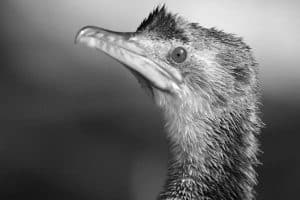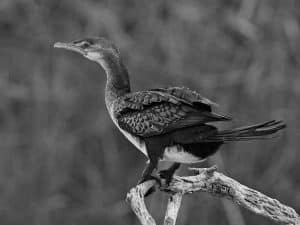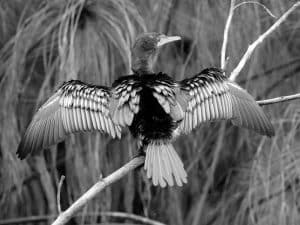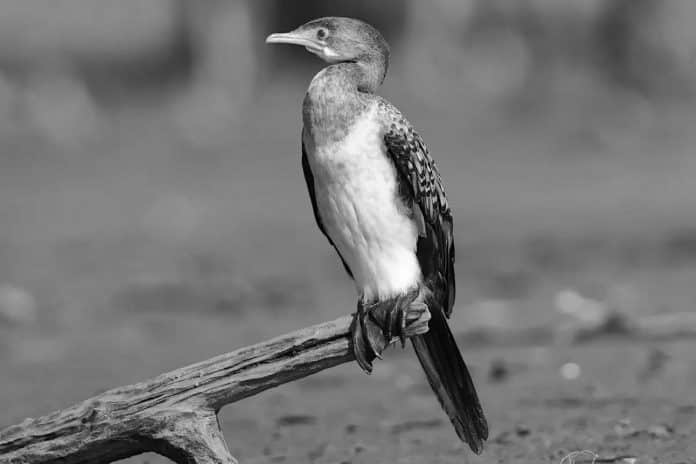Introduction to the Long-Tailed Cormorant
Welcome to the fascinating world of the Long-Tailed Cormorant, a remarkable bird species that graces the diverse ecosystems of Tanzania with its presence. Also known as the African Darter, the Long-Tailed Cormorant in Tanzania is a member of the Phalacrocoracidae family and is renowned for its unique characteristics and behavior. With its long, slender neck, distinctive plumage, and remarkable diving abilities, the Long-Tailed Cormorant is a captivating subject for bird enthusiasts and researchers alike.

Tanzania’s rich and varied landscapes provide the perfect backdrop for the Long-Tailed Cormorant to thrive, from the lush wetlands and rivers to the expansive lakes and coastal regions. As we delve deeper into the world of this remarkable bird, we will uncover its habitat, distribution, behavior, feeding habits, and the crucial role it plays in Tanzania’s intricate ecosystems.
Habitat and Distribution of Long-Tailed Cormorants in Tanzania
The Long-Tailed Cormorant is a highly adaptable bird that can be found in a wide range of habitats across Tanzania. From the serene shores of Lake Victoria to the meandering rivers of the Selous Game Reserve, these elegant birds have made their mark in various ecosystems, showcasing their resilience and versatility. Their preferred habitats include freshwater bodies such as lakes, rivers, and marshes, where they can forage for fish and other aquatic prey with ease.
In Tanzania, the Long-Tailed Cormorant’s distribution is widespread, with significant populations residing in the country’s numerous national parks, game reserves, and wetlands. These birds are known to breed in communal colonies, where they build their nests in trees or reed beds near water bodies, providing a spectacle for birdwatchers and nature enthusiasts. Understanding the habitat and distribution of Long-Tailed Cormorants is crucial for conservation efforts and ensuring the preservation of their natural environments.
Behavior and Feeding Habits of Long-Tailed Cormorants
The behavior and feeding habits of Long-Tailed Cormorants are truly fascinating to observe. These birds are adept divers, using their streamlined bodies and powerful webbed feet to propel themselves underwater in search of prey. With their sharp, hooked beaks, they skillfully catch fish, crustaceans, and other aquatic creatures, showcasing their remarkable hunting prowess.
When not diving for food, Long-Tailed Cormorants can be seen perched on branches or rocks near water, spreading their wings to dry after a successful fishing expedition. Their social nature is also evident in their communal breeding colonies, where they engage in courtship displays and intricate rituals, adding to the allure of these captivating birds. Understanding the behavior and feeding habits of Long-Tailed Cormorants provides valuable insights into their ecological role and impact on their surrounding ecosystems.
Conservation Efforts for Long-Tailed Cormorants in Tanzania
As with many species of wildlife, the Long-Tailed Cormorant faces various conservation challenges in Tanzania. Human activities such as habitat destruction, pollution, and overfishing can significantly impact the populations of these birds and threaten their long-term survival. Conservation efforts aimed at protecting their habitats, regulating fishing practices, and raising awareness about the importance of these birds are crucial for their preservation.
Tanzania has made significant strides in implementing conservation measures to safeguard the Long-Tailed Cormorant and other avian species. Through the establishment of protected areas, environmental education initiatives, and collaborative research projects, efforts are underway to mitigate the threats facing these remarkable birds. By supporting conservation efforts, individuals, organizations, and governments can contribute to the sustainable coexistence of humans and Long-Tailed Cormorants in Tanzania.
Best Places for Birdwatching Long-Tailed Cormorants in Tanzania

For bird enthusiasts and nature lovers, Tanzania offers a wealth of opportunities to observe Long-Tailed Cormorants in their natural habitats. From the iconic Serengeti National Park to the stunning landscapes of the Ngorongoro Conservation Area, the country’s diverse ecosystems provide ideal settings for birdwatching and wildlife photography. The tranquil shores of Lake Tanganyika and the picturesque wetlands of the Selous Game Reserve are particularly renowned for their abundance of Long-Tailed Cormorants.
The southern and western regions of Tanzania also offer prime birdwatching locations, with the Rufiji River and Lake Rukwa serving as havens for these elegant birds. Whether embarking on a guided birdwatching tour or exploring the wilderness independently, visitors to Tanzania can immerse themselves in the beauty of nature and witness the captivating sight of Long-Tailed Cormorants in their element. By promoting responsible ecotourism and supporting local conservation initiatives, individuals can contribute to the protection of these avian treasures.
The Role of Long-Tailed Cormorants in Tanzania’s Ecosystem
Long-Tailed Cormorants play a vital role in Tanzania’s intricate ecosystems, contributing to the balance and dynamics of aquatic environments. As proficient fish hunters, these birds help regulate fish populations, thereby influencing the overall health and productivity of freshwater ecosystems. By controlling certain fish species, Long-Tailed Cormorants indirectly impact the composition of aquatic communities, demonstrating their significance as ecological influencers.
Furthermore, the presence of Long-Tailed Cormorants can serve as indicators of environmental quality, reflecting the condition of water bodies and the availability of suitable habitats for aquatic life. Monitoring the populations and behaviors of these birds provides valuable insights into the ecological well-being of Tanzania’s wetlands, lakes, and rivers. Recognizing the role of Long-Tailed Cormorants in the broader context of ecosystem dynamics is essential for informed conservation and management strategies.
Challenges Facing Long-Tailed Cormorants in Tanzania
Despite their resilience, Long-Tailed Cormorants in Tanzania face a myriad of challenges that threaten their populations and habitats. Habitat destruction due to human development, pollution from agricultural runoff and industrial activities, and the impacts of climate change pose significant risks to the well-being of these birds. Additionally, unsustainable fishing practices and human disturbance near breeding sites can disrupt the natural behaviors and reproductive success of Long-Tailed Cormorants.
Addressing these challenges requires a multifaceted approach that integrates conservation, research, and community engagement. By identifying and mitigating the specific threats faced by Long-Tailed Cormorants, stakeholders can work towards ensuring the sustainable coexistence of these birds and human activities. Through collaborative efforts and proactive measures, it is possible to safeguard the future of Long-Tailed Cormorants in Tanzania and secure the integrity of their habitats.
Unique Features and Adaptations of Long-Tailed Cormorants
The Long-Tailed Cormorant possesses a range of unique features and adaptations that contribute to its remarkable abilities and survival strategies. Its long, slender neck and streamlined body enable efficient underwater navigation and hunting, allowing the bird to pursue prey with precision and agility. The distinctive plumage of the Long-Tailed Cormorant, characterized by dark feathers and a striking white stripe along its neck, serves both functional and aesthetic purposes, enhancing its visibility and allure.
In addition to its physical attributes, the Long-Tailed Cormorant exhibits remarkable behavioral adaptations, such as its communal breeding behavior and elaborate courtship displays. These social dynamics and reproductive rituals are integral to the species’ survival and perpetuation, showcasing the intricate interplay of biology and behavior. Understanding the unique features and adaptations of Long-Tailed Cormorants provides valuable insights into their evolutionary history and ecological significance.
Photographing Long-Tailed Cormorants in Tanzania

Photographing Long-Tailed Cormorants in Tanzania offers a rewarding opportunity to capture the beauty and essence of these captivating birds in their natural environments. Whether perched on a treetop overlooking a shimmering lake or gracefully gliding across the water’s surface, Long-Tailed Cormorants present an array of captivating moments for photographers to immortalize. The interplay of light and shadow, the reflections on the water, and the elegant postures of the birds create a rich tapestry of visual storytelling.
To capture stunning images of Long-Tailed Cormorants, photographers can explore a variety of techniques and perspectives, from close-up portraits to expansive landscapes that showcase the birds in their habitats. Patience, observation, and an understanding of avian behavior are essential for anticipating and capturing the decisive moments that convey the essence of these remarkable birds. By approaching wildlife photography with respect for the natural world and an appreciation for the subjects, photographers can create compelling visual narratives that celebrate the beauty of Long-Tailed Cormorants in Tanzania.
Conclusion and the Future of Long-Tailed Cormorants in Tanzania
In conclusion, the Long-Tailed Cormorant stands as a symbol of resilience, adaptability, and natural beauty in Tanzania’s diverse ecosystems. As we continue to explore and appreciate the intricate connections between these birds and their environments, it becomes evident that their well-being is intertwined with the health of aquatic ecosystems and the preservation of natural habitats. By supporting conservation efforts, responsible ecotourism, and environmental education, individuals can contribute to the sustainable future of Long-Tailed Cormorants in Tanzania.


































